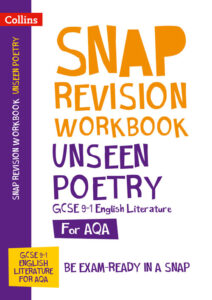 Any examination is a contained and isolating space, the examinee on their own, having to rely on themselves to navigate their way and manage their time. The unseen poetry section is often considered the place containing the highest degree of challenge because of the unfamiliarity of the poem(s) presented. And not only this, poetry is perceived as ‘difficult’ to start with, so an unseen poem comes with a double layer of perceived difficulty. Even the word ‘unseen’ feels unhelpful to me, adding to fears that the meaning of the poem(s) might be indistinct and invisible and that floundering is the order of the day. But, with the right kind of guidance, nurturing and some active, collaborative and experiential learning, this section of the examination can become a more inviting place.
Any examination is a contained and isolating space, the examinee on their own, having to rely on themselves to navigate their way and manage their time. The unseen poetry section is often considered the place containing the highest degree of challenge because of the unfamiliarity of the poem(s) presented. And not only this, poetry is perceived as ‘difficult’ to start with, so an unseen poem comes with a double layer of perceived difficulty. Even the word ‘unseen’ feels unhelpful to me, adding to fears that the meaning of the poem(s) might be indistinct and invisible and that floundering is the order of the day. But, with the right kind of guidance, nurturing and some active, collaborative and experiential learning, this section of the examination can become a more inviting place.
Modelling some of the strategies students will need to adopt in this section of the examination is the first stage of the process. Show them that any poem, because it is condensed, requires careful reading that attends to line breaks, run-on lines and internal punctuation. Reading poetry aloud should be savoured and you need to provide them with examples of how to do this well. This does not require performance skills on your part, just a little practice in reading poetry attentively and slowly, using the prosody of your voice – stress, pace, volume and pitch to alert them to meaning, structure and rhythm.
Share with them your impressions of the opening few lines of a poem as you read it; the questions that arise in your mind; the words, phrases or lines that puzzle you. The patterns (rhyme, imagery, lexical fields, spoken features) that are surfacing as you read. Be tentative. Show that you can’t be certain, until you have read the poem in a sustained and careful way more than once, what it is about or how it makes you feel. Reassure them that they don’t have to write about everything, just the key features that come foremost to their attention and reveal something of the poem’s meaning to them. If you model the sustained and careful reading, re-reading and internal commenting they need to do, they will have a better understanding of how to replicate this in the examination.
Let’s take the opening to ‘Quiet Zone’ by Roger McGough. This poem has a dedicatee as well as a title.
(Poem for a lady on the Bristol to Paddington train, who spent the journey in the ‘Quiet Coach’, chatting on her mobile phone.)
Pause at this point and think aloud about the tone of the dedication. Explore the function of the dedication. Express your thoughts as they occur. You can sound cautious and unsure. Then read the first five lines.
With respect, this is the quiet zone.
And although when travelling on you own
It’s nice to have a good old chat
With someone on the phone
This is the quiet zone.
You might want to consider: the phrase, ‘With respect’; the colloquial expression ‘a good old chat’; the repetition of the statement, ‘this is the quiet zone’ and how the prosody might vary between its two uses. You can invite learners to play around with the prosody – individuals can be asked to read the lines in the following voices: polite, friendly, judgemental, angry, superior and so on.
In order to make this coaxing of meaning more collaborative, you can then show them an annotated version of your thoughts and observations on these first few lines. Your annotation needs to be clear and not too dense. Use a consistent method, such as circling words relating to key lexical fields, underlining rhymes, noting the run-on lines with a connector arrow and so on. They can then use this as a model for tackling the rest of the poem. You can pace this part of the activity by asking them to look at a specific number of lines before pausing. Encourage students to share their observations, questions or puzzlements. Try and get as much participation as possible.
Make sure that you focus their thinking so that they begin to appreciate features and techniques as well as content. Your opening has already alerted them to tone and some features used to mimic speech, but you might also want them to think about the uneven structure of the poem. Pause and encourage them to read closely and think about the questions posed by the speaker. How many are there? How do they sound? How do they build up? What sort of questions are they? Do they imagine them being asked slowly or quickly? Why?
These tentative readings, based on active, collaborative and experiential learning, are building blocks for the analysis of unseen poems. Showing students how to read aloud, look, listen, reflect and have fun, whilst reading closely and critically, helps them to connect with and get to know poetry. It also gives them some useful strategies for animating that silent reading they have to do in the examination.

Renée Stanton is the author of the Collins GCSE 9-1: Unseen Poetry Workbook.
Renée has been teaching English for over 30 years, working at two sixth form colleges and more recently at a university. She has a PhD in English Literature. She has been a Principal Moderator and Principal Examiner for AQA and continues to be involved in external assessment for other specification providers such as Cambridge International (CIE), WJEC and the European Baccalaureate. She now works as a freelance writer and English tutor.


